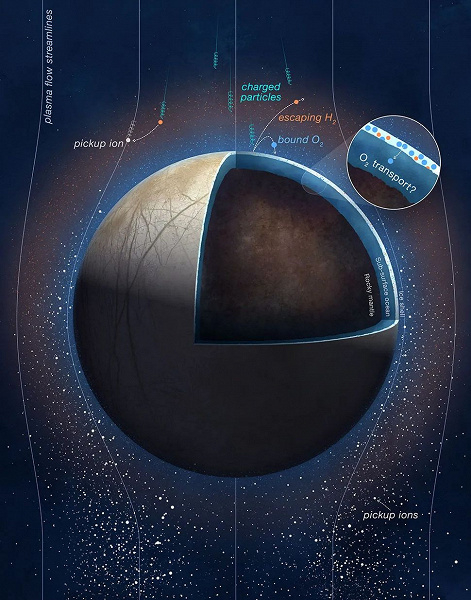The study found that previous estimates of Europa's oxygen content were overestimated
March 4, scientists announced the result of their study, in which they were able to measure the amount of molecular oxygen around Jupiter's moon Europa. Previously, researchers had only roughly estimated the oxygen content on this icy moon, but for the first time they were able to make direct measurements.
The study results were lower than previous estimates. This has raised questions about the habitability potential of Europa, which is believed to hide a water ocean beneath its surface. Or at least the conditions for life as we know it to arise. However, this discussion requires further research.
Previous estimates of Europa's oxygen content were based on atomic oxygen emissions. Unlike molecular oxygen, which consists of two atoms, atomic oxygen consists of only one atom. Although atomic oxygen cannot be used for breathing, scientists believed that measuring its content in Europa's atmosphere would allow us to draw conclusions about the presence of breathable oxygen on this satellite.
New research has narrowed down previous predictions even further. Scientists have directly measured the oxygen content on Europa using the Juno probe.
As the team explains in the study, there are chemical reactions that can convert some of Europa's frozen water molecules into molecular hydrogen and molecular oxygen. And if such reactions really took place, then the proof would be the appearance of oxygen and hydrogen ions around the satellite — ions, since they would carry electrical charges. The strong radiation field of Jupiter, through which Europa's orbit passes, plays an important role in this process: the theory had a strong basis, since Europa's orbital path passes through one of Jupiter's radiation belts. This belt contains many charged particles that can impact the lunar surface, potentially causing the process of water splitting.
In September 2022, the Juno probe, located 354 kilometers from Europa, discovered evidence of such water splitting. Hydrogen and oxygen ions, formed during the “bombardment of charged particles,” were captured by Jupiter’s magnetic field.
Scientists have concluded that Europa’s atmosphere generates about 12 kilograms of molecular oxygen every second. This is significantly less than previous estimates, which reached 900 kilograms per second.
These results indicate a more limited habitability of Europa's ocean. Scientists plan to continue research and conduct similar measurements on another satellite of Jupiter — And about. Further research will help expand knowledge about the possible conditions and prevalence of life in our solar system.

